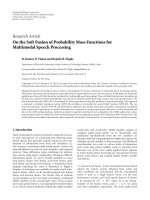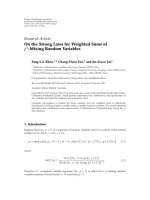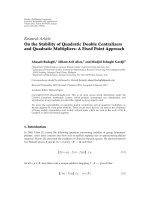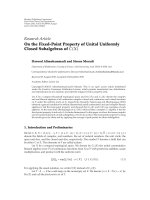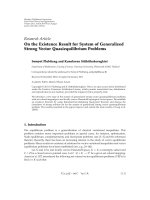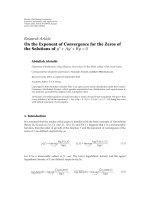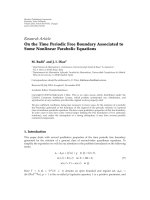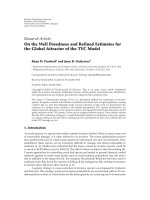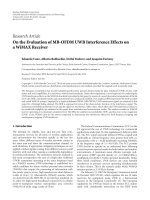Báo cáo hóa học: " Research Article On the Fixed-Point Property of Unital Uniformly Closed Subalgebras of C X" docx
Bạn đang xem bản rút gọn của tài liệu. Xem và tải ngay bản đầy đủ của tài liệu tại đây (501.68 KB, 9 trang )
Hindawi Publishing Corporation
Fixed Point Theory and Applications
Volume 2010, Article ID 268450, 9 pages
doi:10.1155/2010/268450
Research Article
On the Fixed-Point Property of Unital Uniformly
Closed Subalgebras of CX
Davood Alimohammadi and Sirous Moradi
Department of Mathematics, Faculty of Science, Arak University, Arak 38156-8-8349, Iran
Correspondence should be addressed to Davood Alimohammadi,
Received 25 August 2010; Accepted 24 December 2010
Academic Editor: Lai Jiu Lin
Copyright q 2010 D. Alimohammadi and S. Moradi. This is an open access article distributed
under the Creative Commons Attribution License, which permits unrestricted use, distribution,
and reproduction in any medium, provided the original work is properly cited.
Let X be a compact Hausdorff topological space and let CX and C
R
X denote the complex
and real Banach algebras of all continuous complex-valued and continuous real-valued functions
on X under the uniform norm on X, respectively. Recently, Fupinwong and Dhompongsa 2010
obtained a general condition for infinite dimensional unital commutative real and complex Banach
algebras to fail the fixed-point property and showed that C
R
X and CX are examples of such
algebras. At the same time Dhompongsa et al. 2011 showed that a complex C
∗
-algebra A has the
fixed-point property if and only if A is finite dimensional. In this paper we show that some complex
and real unital uniformly closed subalgebras of CX do not have the fixed-point property by using
the results given by them and by applying the concept of peak points for those subalgebras.
1. Introduction and Preliminaries
We let C, R, N {1, 2, 3, }, T {z ∈ C : |z| 1}, D {z ∈ C : |z| < 1}, D {z ∈ C : |z|≤1}
denote the fields of complex, real numbers, the set of natural numbers, the unit circle, the
open unit disc, and the closed unit disc, respectively. The symbol F denotes a field that can
be either C or R. The elements of F are called scalars.
Let X be a compact topological space. We denote by C
F
X the unital commutative
Banach algebra over F of continuous functions from X to F with pointwise addition, scalar
multiplication, and product with the uniform norm
f
X
sup
f
x
: x ∈ X
f ∈ C
F
X
. 1.1
For applying the usual notation, we write CX instead of C
C
X.
Let T : E → E be a self-map on the nonempty set E. We denote {x ∈ E : Txx} by
FixT and call the fixed-points set of T.
2 Fixed Point Theory and Applications
Let X be a normed space over the field F. A mapping T : E ⊆ X → X is nonexpansive
if Tf − Tg≤f − g for all f, g ∈ E. We say that the normed space X has the fixed-point
property if for every nonempty bounded closed convex subset E of X and every nonexpansive
mapping T : E → E we have FixT
/
∅. One of the central goals in fixed point theory is to
find which Banach spaces have the fixed-point property.
Let A be a unital algebra over F with unit 1 and let GA denote the set of all
invertible elements of A. We define the spectrum of an element f of A to be the set {λ ∈
F : λ1 − f/∈ GA} and denote it by σ
f.Thespectral radius of f, denoted by rf,is
defined to be sup{|λ| : λ ∈ σf}.NotethatifA is a unital complex Banach algebra, then
rflim
n →∞
f
n
1/n
inf{f
n
1/n
: n ∈ N} see 1, Theorem 10.13.
A character on a unital algebra A over F is a nonzero homomorphism ϕ : A → F.We
denote by ΩA the set of all characters on A.IfA is a unital commutative complex Banach
algebra, ΩA
/
∅ and σf{ϕf : ϕ ∈ ΩA} for all f ∈ A see 2, 3.NotethatifA is
real algebra, it may be the case that ΩA∅ see 4, Example 2.4 and Example 3.9 below
or ΩA
/
∅ and σf
/
{ϕf : ϕ ∈ ΩA}see Example 3.8 below.
Let A be a unital commutative real Banach algebra. A complex character on A is a
nonzero homomorphism ϕ : A → C, regarded as a real algebra. The set of all complex
character on A is called the carrier space of A and denoted by CarA. Obviously, ΩA ⊆
CarA.
Let X be a compact topological space and let A be a unital uniformly closed subalgebra
of C
F
X. For each x ∈ X, the map ε
x
: A → F defined by ε
x
ffx, belongs to ΩA
which is called the evaluation character on A at x. It is known that ΩCX {ε
x
: x ∈ X}.
Let F be a collection of complex-valued functions on a nonempty set X. We say that:
i F separates the points of X if for each x, y ∈ X with x
/
y, there is a function f in F
such that fx
/
fy;
ii F is self-adjoint if f ∈Fimplies that
f ∈F;
iii F is inverse-closed if 1/f ∈Fwhenever f ∈Fand fx
/
0 for all x ∈ X.
Let A be a unital commutative complex Banach algebra. It is known that each ϕ ∈
ΩA is continuous and ϕ 1. For each f ∈ A, we define the map
f : ΩA → C by
fϕϕfϕ ∈ ΩA and say that
f is the Gelfand transform of f. We denote the set
{
f : f ∈ A} by
A. It is easy to see that
A separates the points of ΩA.TheGelfand topology
of ΩA is the weakest topology on
ΩA for which every
f ∈
A is continuous. In fact, the
Gelfand topology of ΩA coincides with the relative topology on ΩA which is given by
weak
∗
topology of A
∗
, the dual space of A.WeknowthatΩA with the Gelfand topology
is a compact Hausdorff topological space and
A is a complex subalgebra of CΩA see
1, 3. Clearly, the following statements are equivalent.
i
A is self-adjoint.
ii For each f ∈ A, there exists an element g ∈ A such that ϕg
ϕf for all ϕ ∈ ΩA.
Let X be a topological space. A self-map τ : X → X is called a topological involution
on X if τ is continuous and ττx x for all x ∈ X.LetX be a compact Hausdorff
topological space and τ be a topological involution on X. We denote by CX, τ the set of
all f ∈ CX for which
f ◦ τ f. Then CX, τ is a unital uniformly closed real subalgebra
of CX which separates the points of X, does not contain the constant function i and we
have CXCX, τ ⊕ iCX, τ. Moreover, CX, τC
R
X if and only if τ is the identity
Fixed Point Theory and Applications 3
map on X.LetA be a unital uniformly closed real subalgebra of CX, τ. For each x ∈ X the
map e
x
: A → C defined by e
x
ffx, is a complex character on A which is called the
evaluation complex character on A at x. We know that CarCX, τ {e
x
: x ∈ X} see 5.The
algebra CX, τ was first introduced by Kulkarni and Limaye in 6. We denote by C
R
X, τ
the set of all f ∈ CX, τ for which f is real-valued on X. Then C
R
X, τ is a unital uniformly
closed real subalgebra of CX, τ.
Let X be a compact Hausdorff topological space and let A be a unital real or complex
subspace of CX. A nonempty subset P of X called a peak set for A if there exists a function f
in A such that P {x ∈ X : fx1} and |fy| < 1 for all y ∈ X \ P, the function f is said to
peak on P. If the peak set P for A is the singleton {x}, we call x a peak point for A.Thesetofall
peak points for A is denoted by S
0
A, X. A nonempty subset E of X is called a boundary for
A, if for each f ∈ A there is an element x of E such that f
X
|fx|. Clearly, S
0
A, X ⊆ E
whenever E is a boundary for A. It is known that, if X is a first countable compact Hausdorff
topological space then S
0
CX,XX see 7.
Let τ be a topological involution on a compact Hausdorff topological space X and let
A be a unital uniformly closed real subspace of CX, τ.IfP ⊆ X is a peak set for A, then
τP P.
Definition 1.1. Let τ be a topological involution on a compact Hausdorff topological space X
and A be a unital uniformly closed real subspace of CX, τ. We say that x ∈ X is a τ-peak
point for A if {x, τx} is a peak set for A. We denote by T
0
A, X, τ the set of all τ-peak points
for A.
Let X be a compact Hausdorff topological space and τ be a topological involution on
X.LetB be a unital uniformly closed subalgebra of CX such that
f ◦ τ ∈ B for all f ∈ B
and define A {f ∈ B :
f ◦ τ f}. Then A is a unital uniformly closed real subalgebra of
CX, τ, B A ⊕ iA, S
0
A, XS
0
B, X ∩ Fixτ and T
0
A, X, τS
0
B, Xsee 5.
Fupinwong and Dhompongsa studied the fixed-point property of unital commutative
Banach algebras over field F in 4. In the case F R, they obtained the following results.
Theorem 1.2 see 4, Theorem 3.1. Let A be an infinite dimensional unital commutative real
Banach algebra satisfying each of the following:
iΩA
/
∅ and σf{ϕf : f ∈ ΩA},
ii if f, g ∈ A such that |ϕf|≤|ϕg| for each ϕ ∈ ΩA,thenf≤g,
iii inf{rf : f
∈ A, f 1} > 0.
Then A does not have the fixed-point property.
Theorem 1.3 see 4, Corollary 3.2. Let X be a compact Hausdorff topological space. If C
R
X is
infinite dimensional, then C
R
X fails to have the fixed-point property.
In the case F C, they obtained the following result.
Theorem 1.4 see 4, Theorem 4.3. Let A be an infinite dimensional unital commutative complex
Banach algebra satisfying each of the following:
i
A is self-adjoint,
ii if f, g ∈ A such that |ϕf|≤|ϕg| for each ϕ ∈ ΩA,thenf≤g,
iii inf{rf : f ∈ A, f 1} > 0.
Then A does not have the fixed-point property.
4 Fixed Point Theory and Applications
By using the above theorem, we obtain the following result.
Theorem 1.5. Let X be a compact Hausdorff topological space. If CX is infinite dimensional, then
CX fails to have the fixed-point property.
Dhompongsa et al. studied the fixed-point property of complex C
∗
-algebras in 8 and
obtained the following result.
Theorem 1.6 see 8, Theorem 1.4. The following properties for a complex C
∗
-algebras A are
equivalent:
i A has the fixed-point property;
ii A has finite dimension.
In this paper, we give a general condition for some infinite dimensional unital
uniformly closed subalgebras of CX to fail the fixed-point property by applying Theorems
1.4 and 1.6. By using the concept of peak points for unital uniformly closed subalgebras of
CX, we show that some of these algebras do not have the fixed-point property. We also
prove that C
R
X, τ and CX, τ fail to have the fixed-point property. By using the concept of
τ-peak points for unital uniformly closed real subalgebras of CX, τ, we show that some of
these algebras do not have the fixed-point property.
2. FPP of Complex Subalgebras of CX
We first obtain a general condition for infinite dimensional unital uniformly closed
subalgebra of CX to fail the fixed-point property and give an infinite collection of these
algebras.
Theorem 2.1. Let X be a compact topological space. If A is a infinite dimensional self-adjoint
uniformly closed subalgebras of CX,thenA does not have the fixed-point property.
Proof. By hypothesises, A is an infinite dimensional complex C
∗
-algebra under the natural
involution f→
f : A → A. Then, A does not have the fixed-point property by Theorem 1.6.
Example 2.2. Let m ∈ N and let A
m
be the uniformly closed subalgebra of CT generated by
1,Z
2m
and Z
2m
, where Z is the coordinate function on T. Then A
m
is an infinite dimensional
self-adjoint uniformly closed subalgebra of CT and so A
m
does not have the fixed-point
property.
Proof. It is easy to see that A
m
is self-adjoint. To complete the proof, it is enough to show that
A
m
is infinite dimensional. We define the sequence {f
m, n
}
∞
n0
of elements of A
m
by
f
m,0
1,f
m,n
Z
2
n
m
− 1
n ∈ N
.
2.1
We can prove that for each n ∈ N the set {f
m,0
,f
m,1
, ,f
m,n
} is a linearly independent set of
elements of A
m
. Therefore, A
m
is infinite dimensional.
Fixed Point Theory and Applications 5
We now show that some of the unital uniformly closed subalgebras of CX fail to
have the fixed-point property by using the concept of peak points for these algebras.
Theorem 2.3. Let X be a compact Hausdorff topological space and let A be a unital uniformly closed
complex subalgebra of CX.IfS
0
A, X contains a limit point of X,thenA does not have the fixed-
point property.
Proof. Let x
0
∈ S
0
A, X be a limit point of X. Then there exists a function f
0
∈ A with
f
0
x
0
0and|f
0
x| < 1 for all x ∈ X \{x
0
}, and there exists a net {x
α
}
α
in X \{x
0
} such
that lim
α
x
α
x in X. We define E {f ∈ A : f
X
fx
0
1}. Then E is a nonempty
bounded closed convex subset of A and f
0
f ∈ E for all f ∈ E. We define the map T : E → E
by Tff
0
f.ItiseasytoseethatT is a nonexpansive mapping on E.
We claim that FixT∅. Suppose f
1
∈ FixT. Then f
0
f
1
f
1
and so f
1
x0 for all
x ∈ X \{x
0
}. The continuity of f
1
in x
0
implies that lim
α
f
1
x
α
f
1
x
0
. Therefore, f
1
x
0
0,
contradicting to f
1
∈ E. Hence, our claim is justified. Consequently, A does not have the
fixed-point property.
Corollary 2.4. Let X be a perfect compact Hausdorff topological space. If A is a unital uniformly
closed subalgebras of CX with S
0
A, X
/
∅,thenA does not have the fixed-point property.
Example 2.5. Let A
D denote the disk algebra, the complex Banach algebra of all continuous
complex-valued functions on
D which are analytic on D under the uniform norm f
D
sup{|fz| : z ∈
D} f ∈ AD. Then AD does not have the fixed-point property.
Proof. Clearly
D is a perfect compact Hausdorff topological space and AD is a unital
uniformly closed complex subalgebra of C
D. By the principle of maximum modulus,
S
0
AD, D ⊆ T.Nowletλ ∈ T. It is easy to see that the function f : D → C, defined by
fz1/21
λz, belongs to AD and peaks at λ. Therefore, S
0
AD, DT. It follows
that A
D does not have the fixed-point property by Corollary 2.4.
Now by giving an example we show that the converse of Theorem 2.3 is not necessarily
true, in general.
Example 2.6. Let J be an uncountable set and let X
α
be the unit closed interval 0, 1 with the
standard topology for each α ∈ J. Suppose X
α∈J
X
α
with the product topology. Then
CX fails to have the fixed-point property but S
0
CX,X∅ and so S
0
CX,X does not
contain any limit points of X.
Proof. Clearly, X is an infinite compact Hausdorff topological space. Choose a sequence
{x
n
}
∞
n1
in X such that x
j
/
x
k
, where j, k ∈ N and j
/
k. By Urysohn’s lemma, there exists
a sequence {h
n
}
∞
n1
in CX such that h
1
1andh
n
x
1
··· h
n
x
n−1
0,h
n
x
n
1for
all n ≥ 2. It is easy to see that the set {h
1
, ,h
n
} is a linearly independent set in CX for all
n ∈ N.Thus,CX is an infinite dimensional complex vector space. Therefore, CX does not
have the fixed-point property by Theorem 1.5.
We now show that S
0
CX,X∅. We assume that E is the set of all x x
α
α∈J
∈ X
for which there is a countable subset I
x
of J such that x
α
0 for all α ∈ J \ I
x
and F is the
set of all x
x
α
α∈J
∈ X for which there is a countable subset J
x
of J such that x
α
1 for all
α ∈ J \ J
x
. Clearly, E ∩ F ∅. It is easy to see that E and F are boundaries for CX. Therefore,
S
0
CX,X∅.
6 Fixed Point Theory and Applications
Remark 2.7. Let X be an infinite first countable compact Hausdorff topological space. Then
S
0
CX,XX,andX has at least one limit point. Hence S
0
CX,X contains a limit point
of X. Therefore, CX fails to have the fixed-point property by Theorem 2.3.
3. FPP of Real Subalgebras of CX
We first give a sufficient condition for unital uniformly closed real subalgebras of C
R
X to
fail the fixed-point property.
Lemma 3.1. If A is a unital commutative real Banach algebra with ΩA
/
∅,then{ϕf : ϕ ∈
ΩA}⊆σf for all f ∈ A.
Proof. Let f ∈ A. For each ϕ ∈ ΩA, we define g
ϕ
ϕf1 − f. Then g
ϕ
∈ A and ϕg
ϕ
0.
Therefore, g
ϕ
/∈ GA and so ϕf ∈ σf.
Lemma 3.2. Let X be a compact topological space. If A is an inverse closed unital uniformly closed
real subalgebra of C
R
X,thenΩA
/
∅, ΩA{ε
x
: x ∈ X} and σf{ϕf : ϕ ∈ ΩA} for
all f ∈ A.
Proof. Since A is a unital real subalgebra of C
R
X, ε
x
∈ ΩA for all x ∈ X. Therefore,
ΩA
/
∅ and so {ϕf : ϕ ∈ ΩA}⊆σf for all f ∈ A by Lemma 3.1.
Now, let f ∈ A and let λ ∈ C \{ϕf : ϕ ∈ ΩA}. Then λ − ϕf
/
0 for each ϕ ∈ ΩA,
and so λ1 − fx
/
0 for all x ∈ X. Therefore, λ1 − f ∈ GA because
A is inverse-closed. It
follows that λ ∈ C \ σf and so σf ⊆{ϕf : ϕ ∈ ΩA}. We now show that ΩA ⊆{ε
x
:
x ∈ X}. Suppose ϕ ∈ ΩA \{ε
x
: x ∈ X}.Letx ∈ X. Then there exists a function f
x
in A
such that ϕf
x
/
f
x
x. We define g
x
f
x
− ϕf
x
1. Then g
x
∈ A, ϕg
x
0andg
x
x
/
0.
The continuity of g
x
on X implies that there exists a neighborhood U
x
of x in X such that
g
x
y
/
0 for all y ∈ U
x
. By compactness of X, there exist finite elements x
1
, ,x
m
of X such
that X
m
j1
U
x
j
. Define g
m
j1
g
x
j
2
. Clearly, g ∈ A and ϕg0. Moreover, gy
/
0
for all y ∈ X. Since A is inverse-closed, 1/g ∈ A. It follows that ϕg
/
0. This contradiction
implies that ΩA ⊆{ε
x
: x ∈ X}.
Theorem 3.3. Let X be a compact topological space. If A is an infinite dimensional inverse-closed
unital uniformly closed real subalgebra of C
R
X,thenA does not have the fixed-point property.
Proof. Since A is a unital uniformly closed real subalgebras of C
R
X, we have ΩA
/
∅,
ΩA{ε
x
: x ∈ X} and σf{ϕf : ϕ ∈ ΩA} {fx : x ∈ X} for all f ∈ A
by Lemma 3.2. Therefore, rfsup{|fx| : x ∈ X} f
X
for all f ∈ A. It follows that
inf{rf : f ∈ A, f
X
1} > 0. Now, let f, g ∈ A with |ϕf|≤|ϕg| for all ϕ ∈ ΩA.
Then, |fx|≤|gx| for each x ∈ X and so f
X
≤g
X
. Since A is infinite dimensional, we
conclude that A does not have the fixed-point property by Theorem 1.2.
Proposition 3.4. Let X be an infinite compact Hausdorff topological space and let τ be a topological
involution on X.Then
i C
R
X, τ is infinite dimensional;
ii CX, τ is infinite dimensional.
Fixed Point Theory and Applications 7
Proof. Choose a sequence {x
n
}
∞
n1
in X such that x
j
/
x
k
, where j, k ∈ N and j
/
k. By Urysohn’s
lemma, there exists a sequence {h
n
}
∞
n1
in C
R
X such that h
1
1andh
n
x
1
h
n
τx
1
··· h
n
x
n−1
h
n
τx
n−1
0, h
n
x
n
h
n
τx
n
1 for all n ≥ 2. We define the sequence
{f
n
}
∞
n1
in C
R
X, τ as the following:
f
1
1,f
n
h
n
◦ τ
h
n
n ∈ N,n≥ 2
. 3.1
It is easy to see that the set {f
1
, ,f
n
} is a linearly independent set in C
R
X, τ for all n ∈ N.
Therefore, C
R
X, τ is an infinite dimensional real vector space. ii Since C
R
X, τ is a real
linear subspace of CX, τ, we conclude that CX, τ is infinite dimensional by i.
Theorem 3.5. Let X be an infinite compact Hausdorff topological space and let τ be a topological
involution on X.ThenC
R
X, τ does not have the fixed-point property.
Proof. By part i of Proposition 3.4, C
R
X, τ is an infinite dimensional real vector space.
On the other hand, C
R
X, τ is an inverse-closed unital uniformly closed real subalgebras
of C
R
X. Therefore, C
R
X, τ does not have the fixed-point property by Theorem 3.3.
Corollary 3.6. Let X be an infinite compact Hausdorff topological space and let τ be a topological
involution on X.ThenCX, τ does not have the fixed-point property.
Proof. By Theorem 3.5, C
R
X, τ does not have the fixed-point property. Since CX, τ, ·
X
is a real Banach space and C
R
X, τ is a uniformly closed real subspace of CX, τ,we
conclude that CX, τ does not have the fixed-point property.
We now give a characterization of ΩCX, τ as the following.
Theorem 3.7. Let X be an infinite compact Hausdorff topological space and let τ be a topological
involution on X.
i If x ∈ Fixτ,thenε
x
∈ ΩCX, τ,whereε
x
is evaluation character on CX, τ at x.
ii If ϕ ∈ ΩCX, τ, there exists x ∈ Fixτ such that ϕ ε
x
.
iiiΩCX, τ ∅ if and only if Fixτ∅.
Proof. i is obvious. To prove ii,letϕ ∈ ΩCX, τ. Then ϕ ∈ CarCX, τ and so there
exists x ∈ X such that ϕ e
x
, where e
x
is the complex character on CX, τ at x. Since
ϕCX, τ ⊆ R, we conclude that fx ∈ R for all f ∈ CX, τ. Therefore, fτx fx for
all f ∈ CX, τ. It follows that x ∈ Fixτ, because CX, τ separates t he points of X.Thus
e
x
ε
x
and so ϕ ε
x
.
iii This follows from i and ii.
Now by giving two examples, we show that there may be a unital commutative real
Banach algebra that fails to have the fixed-point property without satisfying any of the
conditions of Theorem 1.2.
Example 3.8. Let X be the closed unit interval 0, 1 with the standard topology and let τ be
the topological involution on X defined by τx1 − x. Since Fixτ{1/2}, we have
ΩCX, τ {ε
1/2
} by Theorem 3.7. Define the function f : X → C by fx|1/2 − x|.
Clearly, f ∈ CX, τ and fX0, 1/2.Ifλ ∈ −∞, 1/2 ∪ 1, ∞, then λ1 − f ∈ GCX, τ
8 Fixed Point Theory and Applications
and so λ/∈ σf. On the other hand, λ1 − f/∈ GCX, τ for all λ ∈ 1/2, 1. Therefore,
σf1/2, 1.But
ϕ
f
: ϕ ∈ Ω
C
X, τ
ε
1/2
f
f
1
2
{
0
}
. 3.2
Thus σf
/
{ϕf : ϕ ∈ ΩCX, τ}. This shows that CX, τ does not satisfy in the condition
i of Theorem 1.2,butCX, τ fail to have the fixed-point property by Corollary 3.6.
Example 3.9. Let X −2, −1 ∪ 1, 2 with standard topology and let τ be the topological
involution on X defined by τx−x. Since Fixτ∅, we have ΩCX, τ ∅ by
Theorem 3.7. It shows that CX, τ does not satisfy the condition i
of Theorem 1.2,but
CX, τ fails to have the fixed-point property by Corollary 3.6.
We now show that some of the unital closed real subalgebras of CX, τ fails to have
the fixed-point property by applying the concept of τ-peak points for these algebras.
Theorem 3.10. Let X be a compact Hausdorff topological space and let τ be a topological involution
on X. Suppose A is a unital uniformly closed real subalgebra of CX, τ.IfT
0
A, X, τ contains a
limit point of X,thenA does not have the fixed-point property.
Proof. Let x
0
∈ T
o
A, X, τ be a limit point of X. Then there exists a function f
0
in A with
f
0
x
0
f
0
τx 1and|f
0
x| < 1 for all x ∈ X \{x
0
,τx
0
}, and there exists a net {x
α
}
α
in
X \{x
0
,τx
0
} such that lim
α
x
α
x
0
in X. We define E {f ∈ A : f
X
fx
0
1}. Then
E is a nonempty bounded closed convex subset of A and f
0
f ∈ E for all f ∈ E. We define the
map T : E → E by Tff
0
f.ItiseasytoseethatT is a nonexpansive mapping on E.
We claim that FixT∅. Suppose f
1
∈ FixT. Then f
0
f
1
f
1
and so f
1
x0for
all x ∈ X \{x
0
,τx
0
}. The continuity of f
1
in x
0
implies that lim
α
f
1
x
α
f
1
x
0
. T herefore,
f
1
x
0
0, contradicting to f
1
∈ E. Hence, our claim is justified. Consequently, A does not
have the fixed-point property.
Example 3.11. Let τ be the topological involution on D defined by τzz. We denote by
A
D,τ the set all f ∈ AD for which f ◦ τ f. Then AD,τ is a unital uniformly closed real
subalgebra of C
D and ADAD,τ ⊕ iAD,τ.ByExample 2.5,
T
0
A
D,τ
, D,τ
S
0
A
D
, D
T. 3.3
Therefore, A
D,τ does not have the fixed-point property by Theorem 3.10.
Acknowledgment
The authors would like to thank the referees for some helpful comments.
References
1 W. Rudin, Functional Analysis, International Series in Pure and Applied Mathematics, McGraw-Hill,
New York, NY, USA, 2nd edition, 1991.
2 W.
˙
Zelazko, Banach Algebras, Polish Scientific Publishers, Warsaw, Poland, 1973.
Fixed Point Theory and Applications 9
3 G. J. Murphy, C
∗
-Algebras and Operator Theory, Academic Press, Boston, Mass, USA, 1990.
4 W. Fupinwong and S. Dhompongsa, “The fixed point property of unital abelian Banach algebras,”
Fixed Point Theory and Applications, vol. 2010, Article ID 362829, 13 pages, 2010.
5 S. H. Kulkarni and B. V. Limaye, Real Function Algebras, vol. 168 of Monographs and Textbooks in Pure and
Applied Mathematics, Marcel Dekker, New York, NY, USA, 1992.
6 S. H. Kulkarni and B. V. Limaye, “Gleason parts of real function algebras,” Canadian Journal of
Mathematics, vol. 33, no. 1, pp. 181–200, 1981.
7 A. Browder, Introduction to Function Algebras, W. A. Benjamin, New York, NY, USA, 1969.
8 S. Dhompongsa, W. Fupinwong, and W. Lawton, “Fixed point properties of C
∗
-algebras,” Journal of
Mathematical Analysis and Applications, vol. 374, pp. 22–28, 2011.
